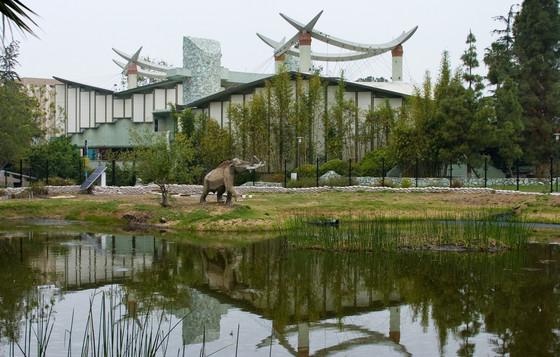This fall, the Pavilion for Japanese Art will celebrate its 30th anniversary. The last structure and only major public building designed by architect Bruce Goff (1904–1982), an idiosyncratic visionary influenced by the organic designs of Frank Lloyd Wright, the Pavilion for Japanese Art divided critics when it opened on LACMA's campus on September 25, 1988. William Wilson, head art critic for the Los Angeles Times, who had eyed the building’s construction “with itching anxiety,” was ecstatic with the end result, calling it a “beautifully balanced architectural solution not rational T-square logic but romantic logic on the order of that exercised by Antonio Gaudi, Paolo Soleri, or Simon Rodia.” Other critics likened the pavilion’s shape, with its convex triangular walls and tusk-like exterior beams, to that of warrior helmets, dinosaurs, mastodons from the adjacent La Brea Tar Pits, ships, and giant shells.

Today, a silent verdict seems to have been issued by the pavilion’s status as a destination site for L.A. residents and visitors. With its colorful history, its unusual, daring, and poetic forms, its unconventional materials, and the utterly unique art-viewing experience it offers, the pavilion has become a fixture at LACMA, a respected structure that three Pritzker Prize–winning architects—Rem Koolhaas, Renzo Piano, and most recently, Peter Zumthor—have deliberately preserved in their respective master plans for the museum’s renovated campus. The 32,100-square-foot pavilion is a three-level building comprising two wings with exhibition galleries, a study area, a library, offices, and storage areas, with the west wing devoted to changing exhibitions, works from LACMA’s permanent collection, and a netsuke gallery to display the Raymond and Frances Bushell Collection of nine hundred exquisite nutshell-sized Japanese sculptures. The east wing was designed for the traditional display of Japanese screens and scrolls, in tokonoma, or traditional viewing spaces, for which the pavilion was originally conceived.

The exterior walls of the Pavilion for Japanese Art are made of Kalwall, a translucent material that permits light to enter a room much the same way a shoji screen does, varying according to time of day, weather, and season, making the movement of the sun and clouds noticeable on the works; the gentle spiraling ramp and petal-like viewing platforms that give the viewer a sense of climbing through a garden, glimpsing art from above and below; the soft shadows that gather in the space and the building’s cream, gray, and green colors reminiscent of clouds, stones, and leaves, provide a contemplative space in the heart of Los Angeles.
For its 30th birthday, we decided to give the Pavilion for Japanese Art the ultimate gift: renewal. While minor cosmetic fixes have been made over the years, the pavilion is due for a comprehensive makeover. Thanks to a generous grant from the County of Los Angeles, the pavilion will undergo much-needed renovation and repairs, and will be closed to the public beginning February 5, 2018 for approximately two years. The Pavilion for Japanese Art is, and always has been, a quiet space—a house of tranquility—and we look forward to welcoming you back after the refurbishment. In the meantime, don't miss the wonderful and serene Atmosphere in Japanese Painting, which, along with the netsuke gallery, is on view in the Pavilion for Japanese Art through February 4, 2018.





